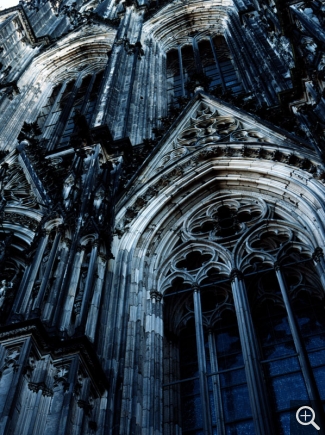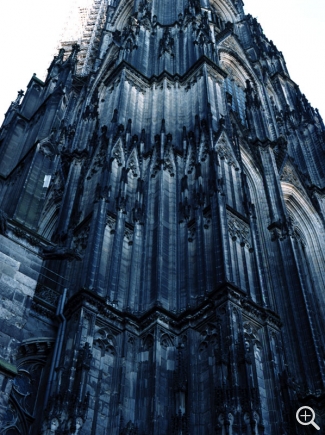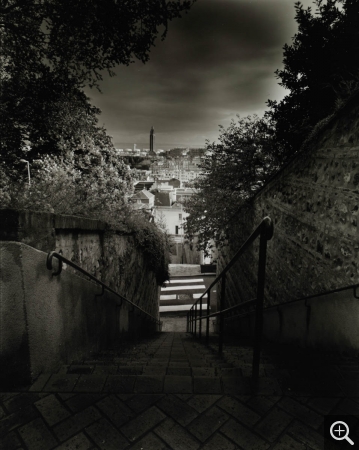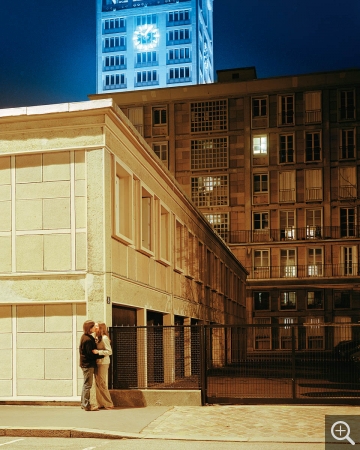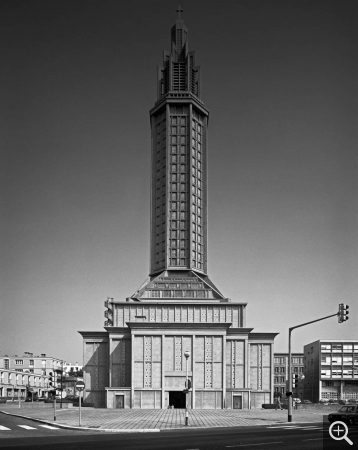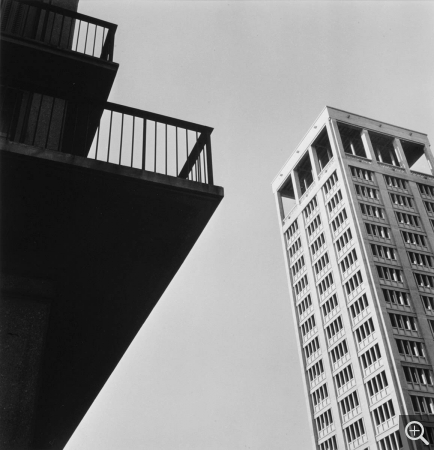Photography
English
Studio MARLOT & CHOPARD
Black Church # 9
2007
colour photography, C-print laminated on aluminum
160 x 120 cm
© MuMa Le Havre / Studio Marlot & Chopard © Adagp, Paris
Black Church # 9
2007
colour photography, C-print laminated on aluminum
160 x 120 cm
© MuMa Le Havre / Studio Marlot & Chopard © Adagp, Paris
Studio MARLOT & CHOPARD
Black Church # 11
2007
colour photography, C-print laminated on aluminum
160 x 120 cm
© MuMa Le Havre / Studio Marlot & Chopard © Adagp, Paris
Black Church # 11
2007
colour photography, C-print laminated on aluminum
160 x 120 cm
© MuMa Le Havre / Studio Marlot & Chopard © Adagp, Paris
Born in Paris in 1972, Rémy Marlot studied photography in Chalon-sur-Saône (Nicéphore Niepce museum), Dijon (École des Beaux-Arts) and Paris. In 1999, he began moving toward an exploration of the urban landscape, the garden, dreams and the night. In addition to photography, he works as a videographer with Ariane Chopard-Guillaumot.
In 2007, Rémy Marlot took a number of photographs of the Cologne Cathedral. Of the forty-five shots taken (in two hours, after a preliminary survey), eleven make up a homogeneous series called "Black Churches". Backlit and shot from below, these large-format photographs (120 x 160 cm) paint an unexpected image of the building.
The view from below gives a dizzying impression that the artist associates with "elevation" and "spirituality". He explains, "I like this tilting where everything is out of my control... lines stream forth, nothing is contained within the frame, everything extends beyond."
Tightly framed, the facades of the Gothic cathedral take on a monochrome appearance through Marlot's lens. The backlighting produces a nocturnal atmosphere, intensifies the contrasts and sculpts each detail of the facade, rendered abstract by the purity and depth of the dark blue colour.
Designed as a series, "Black Churches" are a way of paying homage to the series of "Cathedrals" painted by Claude Monet in Rouen in 1892–1893. Fascinated by the cathedral's ability to dominate them, the two artists transcribe this sensation by bursting the bounds of the frame, as the surface of the building is animated by the subtle plays of light. For did Monet not claim that "everything changes, even stone"?
In 2007, Rémy Marlot took a number of photographs of the Cologne Cathedral. Of the forty-five shots taken (in two hours, after a preliminary survey), eleven make up a homogeneous series called "Black Churches". Backlit and shot from below, these large-format photographs (120 x 160 cm) paint an unexpected image of the building.
The view from below gives a dizzying impression that the artist associates with "elevation" and "spirituality". He explains, "I like this tilting where everything is out of my control... lines stream forth, nothing is contained within the frame, everything extends beyond."
Tightly framed, the facades of the Gothic cathedral take on a monochrome appearance through Marlot's lens. The backlighting produces a nocturnal atmosphere, intensifies the contrasts and sculpts each detail of the facade, rendered abstract by the purity and depth of the dark blue colour.
Designed as a series, "Black Churches" are a way of paying homage to the series of "Cathedrals" painted by Claude Monet in Rouen in 1892–1893. Fascinated by the cathedral's ability to dominate them, the two artists transcribe this sensation by bursting the bounds of the frame, as the surface of the building is animated by the subtle plays of light. For did Monet not claim that "everything changes, even stone"?
Learn more
Olivier MÉRIEL (1955)
Stairs
© MuMa Le Havre / Olivier Mériel
Stairs
© MuMa Le Havre / Olivier Mériel
Born in 1955, Olivier Mériel lives and works in Saint-Aubin-sur-Mer, in the Calvados region of Normandy, an area to which he is strongly attached and has continuously photographed for the past thirty years. Working on public commissions (Conservatoire du littoral, Maison Victor Hugo, Festival Normandie Impressionniste, etc.) or more personal projects, he has travelled the length and breadth of the region, from coast to hedged fields, making the rare stop in cities, like here in Le Havre.
From October 2003 to May 2005, in the spring and throughout the winter, Olivier Mériel travelled regularly to Le Havre with the aim of making a portrait of the city in around fifty photographs. Strolling about and scouting for locations, he combed the city, from the upper town to the district of Les Neiges below. He set up his heavy view camera, chose his hour, his sky, and then took his shots.
Painstakingly constructed, his images are the result of a long creative process. Mériel develops his own photos, through direct contact of the plate with high-silver-content paper and then toning them with platinum and selenium, which lends density and depth to the blacks, and subtlety to the shadows and light.
Olivier Mériel offers a very personal vision of Le Havre. His forty-five prints, taken just a few months before the city centre rebuilt by Auguste Perret was listed as a world heritage site (July 2005), compose a subtle portrait of this port city and its mix of modern and old neighbourhoods, administrative buildings and little working-class houses, quays, avenues, tiny streets and steep staircases, sea and fields of wild grasses, factories and dry docks... But the artist also opens doors and invites us to enter the mysterious world of the Museum of Natural History's reserves or to warm ourselves at the counter of a café down at the harbour.
From October 2003 to May 2005, in the spring and throughout the winter, Olivier Mériel travelled regularly to Le Havre with the aim of making a portrait of the city in around fifty photographs. Strolling about and scouting for locations, he combed the city, from the upper town to the district of Les Neiges below. He set up his heavy view camera, chose his hour, his sky, and then took his shots.
Painstakingly constructed, his images are the result of a long creative process. Mériel develops his own photos, through direct contact of the plate with high-silver-content paper and then toning them with platinum and selenium, which lends density and depth to the blacks, and subtlety to the shadows and light.
Olivier Mériel offers a very personal vision of Le Havre. His forty-five prints, taken just a few months before the city centre rebuilt by Auguste Perret was listed as a world heritage site (July 2005), compose a subtle portrait of this port city and its mix of modern and old neighbourhoods, administrative buildings and little working-class houses, quays, avenues, tiny streets and steep staircases, sea and fields of wild grasses, factories and dry docks... But the artist also opens doors and invites us to enter the mysterious world of the Museum of Natural History's reserves or to warm ourselves at the counter of a café down at the harbour.
Learn more
Véronique ELLENA (1966)
Le Havre. Lovers at City Hall
2007
colour photography laminated on aluminum under Plexiglas
© MuMa Le Havre / Véronique Ellena
Le Havre. Lovers at City Hall
2007
colour photography laminated on aluminum under Plexiglas
© MuMa Le Havre / Véronique Ellena
Born in 1966, Véronique Ellena studied photography in the studio of Gilbert Fastenaekens at the La Cambre school of visual arts in Brussels. She has been exhibiting her series of photographs since 1997: "Sundays" (1997), "Big Moments of Life" (1999), "Classic Cycle Races" (2001), "Those with Faith" (2003). A resident at the French Academy in Rome in 2007, she produced a new series of "Still Lifes" at the Villa Medici. Her most recent work on the homeless ("Invisible") also stems from her time in Rome.
Véronique Ellena came to Le Havre as part of a public commission from the city of Le Havre and the French Ministry of Culture. In 2006, fifty years after Lucien Hervé was awarded the first campaign to photograph Le Havre rebuilt (1956), and one year after the city centre rebuilt by the Auguste Perret studio was listed as a world heritage site (2005), six artists were invited to capture this modern section of the city that most residents still have difficulty accepting. Five photographers (in addition to Véronique Ellena, there were Nancy Wilson-Pajic, Manuela Marques, Charles Decorps and Xavier Zimmermann) and a videographer (Pierre Creton) worked at Le Havre from 2007 to 2009. At the end of their campaign in the spring of 2010, their works were assembled and presented in an exhibition entitled "Le Havre. Images sur commande" organized by the Musée Malraux. Part of the exhibition was also shown in Brazil, in two museums built by Oscar Niemeyer, who was the architect for the new theatre in Le Havre inaugurated in 1982: the Museu de Arte Contemporânea de Niterói (2009–2010) and the Museu Nacional in Brasilia (summer 2010).
Véronique Ellena came to Le Havre in the winter of 2006–2007, soaking up the atmosphere of the city and delving into its history. The modern city calls to mind a theatre set in which nothing is left to chance. She likes the carefully planned perspectives and points of view in which, as on stage, light plays a particularly important role. Véronique Ellena prefers the soft light of dawn or dusk to the light during the day, which she finds too cold. In the evening, the streetlights transform the scenes and give them a film-like quality. The discreet light from apartments shines modestly on the private stages in the street, where passers-by, inhabitants and lovers seem to play their own role. Véronique Ellena offers a calm and silent vision of the city as she gives it the universal image of a theatre of life.
Véronique Ellena came to Le Havre as part of a public commission from the city of Le Havre and the French Ministry of Culture. In 2006, fifty years after Lucien Hervé was awarded the first campaign to photograph Le Havre rebuilt (1956), and one year after the city centre rebuilt by the Auguste Perret studio was listed as a world heritage site (2005), six artists were invited to capture this modern section of the city that most residents still have difficulty accepting. Five photographers (in addition to Véronique Ellena, there were Nancy Wilson-Pajic, Manuela Marques, Charles Decorps and Xavier Zimmermann) and a videographer (Pierre Creton) worked at Le Havre from 2007 to 2009. At the end of their campaign in the spring of 2010, their works were assembled and presented in an exhibition entitled "Le Havre. Images sur commande" organized by the Musée Malraux. Part of the exhibition was also shown in Brazil, in two museums built by Oscar Niemeyer, who was the architect for the new theatre in Le Havre inaugurated in 1982: the Museu de Arte Contemporânea de Niterói (2009–2010) and the Museu Nacional in Brasilia (summer 2010).
Véronique Ellena came to Le Havre in the winter of 2006–2007, soaking up the atmosphere of the city and delving into its history. The modern city calls to mind a theatre set in which nothing is left to chance. She likes the carefully planned perspectives and points of view in which, as on stage, light plays a particularly important role. Véronique Ellena prefers the soft light of dawn or dusk to the light during the day, which she finds too cold. In the evening, the streetlights transform the scenes and give them a film-like quality. The discreet light from apartments shines modestly on the private stages in the street, where passers-by, inhabitants and lovers seem to play their own role. Véronique Ellena offers a calm and silent vision of the city as she gives it the universal image of a theatre of life.
Learn more
Gabriele BASILICO (1944-2013)
Le Havre. Saint-Joseph Church
1984
colour photography, gelatin silver bromide print
60 x 50 cm
© MuMa Le Havre / Gabriele Basilico
Le Havre. Saint-Joseph Church
1984
colour photography, gelatin silver bromide print
60 x 50 cm
© MuMa Le Havre / Gabriele Basilico
Gabriele Basilico lives in Milan, where he was born in 1944. The winner of numerous prizes, he travels the world, endlessly photographing the changing landscapes of our contemporary society.
In the line of the major public commissions that have accompanied the history of photography since its invention in 1839, DATAR (French Delegation for Territorial Development and Regional Action), a non-cultural organization attached to the French Ministry of Planning, launched in 1984 a vast commission to photograph the French landscape with the aim of proposing "a representation of the contemporary landscape to promote its recognition, understanding and transformation. Gabriele Basilico was one of the twenty-eight artists entrusted with a section of the country, in his case the coast of northern France from Dunkirk to Cherbourg. For six months, Basilico travelled throughout the region, stopping at the small coastal resorts, villages and major harbours of the Atlantic coast, without hesitating to capture in his own way the most clichéd images of the French landscape.
Arriving at Le Havre in 1984, Basilico revisited the city centre explored by Lucien Hervé in 1956 and paused before the most important buildings, including the brand new theatre built by Oscar Niemeyer. No trace of humans, the carefully chosen distance from the subject, the sun at its zenith erasing all shadows, accentuate the monumental and classic nature of the architecture. Basilico pursued his exploration of the city in the areas presenting new economic challenges. Over the decades and through various modernization initiatives, the harbour has become progressively removed from the city centre. Basilico wandered through the quays, warehouses, repair shops and dry docks, applying the same shooting method as for the "historic" centre, which had an ennobling effect on the industrial architecture. But unlike the monumentality of the city centre, the artist saw these developing zones as an opportunity to express the emptiness of new urban spaces, another subject of his photographs.
Basilico gave great importance to this project, which he presented in a publication and no less than three exhibitions. He also included it in all of the retrospectives on his work, discussing it at length and even contemplating renewing the experience.
In the line of the major public commissions that have accompanied the history of photography since its invention in 1839, DATAR (French Delegation for Territorial Development and Regional Action), a non-cultural organization attached to the French Ministry of Planning, launched in 1984 a vast commission to photograph the French landscape with the aim of proposing "a representation of the contemporary landscape to promote its recognition, understanding and transformation. Gabriele Basilico was one of the twenty-eight artists entrusted with a section of the country, in his case the coast of northern France from Dunkirk to Cherbourg. For six months, Basilico travelled throughout the region, stopping at the small coastal resorts, villages and major harbours of the Atlantic coast, without hesitating to capture in his own way the most clichéd images of the French landscape.
Arriving at Le Havre in 1984, Basilico revisited the city centre explored by Lucien Hervé in 1956 and paused before the most important buildings, including the brand new theatre built by Oscar Niemeyer. No trace of humans, the carefully chosen distance from the subject, the sun at its zenith erasing all shadows, accentuate the monumental and classic nature of the architecture. Basilico pursued his exploration of the city in the areas presenting new economic challenges. Over the decades and through various modernization initiatives, the harbour has become progressively removed from the city centre. Basilico wandered through the quays, warehouses, repair shops and dry docks, applying the same shooting method as for the "historic" centre, which had an ennobling effect on the industrial architecture. But unlike the monumentality of the city centre, the artist saw these developing zones as an opportunity to express the emptiness of new urban spaces, another subject of his photographs.
Basilico gave great importance to this project, which he presented in a publication and no less than three exhibitions. He also included it in all of the retrospectives on his work, discussing it at length and even contemplating renewing the experience.
Lucien HERVÉ (1910-2007)
City Hall Tower from the ISAI
1956
silver halide photography – paper print
38 x 39 cm
© MuMa Le Havre / Lucien Hervé
City Hall Tower from the ISAI
1956
silver halide photography – paper print
38 x 39 cm
© MuMa Le Havre / Lucien Hervé
Born in Hungary, photographer László Elkán (1910–2007) moved to Paris in 1929 and joined the Resistance under the name Lucien Hervé. His encounter with Le Corbusier in 1949 had a decisive influence on his career. The architect's official photographer, he began working in the 1950s with a number of other artists such as Alvar Aalto, Pier Luigi Nervi, Marcel Breuer and Oscar Niemeyer, to name a few. He travelled the world working on a wide range of assignments (Chandigarh in 1955 and 1961, Brasilia in 1961, etc.).
In an effort to promote the modern image of the city of Le Havre rebuilt by Auguste Perret, the Délégation Générale du Tourisme commissioned a series of photographs from Lucien Hervé in 1956. Known as the "photographer specialized in architecture", he was to "provide images to illustrate a variety of documents distributed on the Atlantic steamers". Within a just few days, in July 1956, Lucien Hervé had taken four hundred shots. Two years after Perret's death (1954), the reconstruction of Le Havre was not yet complete, but the photographer, an ardent fan of the work of Le Corbusier—who had had a number of disputes with Perret—, succeeded in glorifying the modern and urban quality of this classic architecture.
He covered every inch of the city. The views shot from below, rather than from the front, allowed him to break with the regularity of an entire urban space founded on the pattern of vertical and horizontal lines. Hervé played with salient features (sharp edges of balconies, projections from surfaces) and powerful backlit effects for a rigorous structuring of his image. Once the contact prints were developed, he did not hesitate to rework his framing with scissors to find the ideal composition to the nearest millimetre for the finished print.
Although Hervé gave the first modern representation of the reconstructed city, his commission was nevertheless refused. The people of city were obviously not ready to accept the image he offered of Le Havre, for they had lost everything and were still deeply affected by the pain and loss of what had been destroyed in two days of bombing on September 5 and 6, 1944. Only a few images were chosen to illustrate a brochure published by the tourism office, and the rest of the contact prints and negatives were left unused. The photo campaign remained totally ignored until 2002, when a major exhibition on August Perret at the Musée Malraux and the Cité de l'Architecture in Paris led to the rediscovery, almost fifty years later, of over 400 contact prints in the city's archives and tourism office. Lucien Hervé provided his assistance and authorized prints to be made of thirty-three photographs of Le Havre. All were made under his close scrutiny, providing him with another opportunity to rework the framing of his images.
In an effort to promote the modern image of the city of Le Havre rebuilt by Auguste Perret, the Délégation Générale du Tourisme commissioned a series of photographs from Lucien Hervé in 1956. Known as the "photographer specialized in architecture", he was to "provide images to illustrate a variety of documents distributed on the Atlantic steamers". Within a just few days, in July 1956, Lucien Hervé had taken four hundred shots. Two years after Perret's death (1954), the reconstruction of Le Havre was not yet complete, but the photographer, an ardent fan of the work of Le Corbusier—who had had a number of disputes with Perret—, succeeded in glorifying the modern and urban quality of this classic architecture.
He covered every inch of the city. The views shot from below, rather than from the front, allowed him to break with the regularity of an entire urban space founded on the pattern of vertical and horizontal lines. Hervé played with salient features (sharp edges of balconies, projections from surfaces) and powerful backlit effects for a rigorous structuring of his image. Once the contact prints were developed, he did not hesitate to rework his framing with scissors to find the ideal composition to the nearest millimetre for the finished print.
Although Hervé gave the first modern representation of the reconstructed city, his commission was nevertheless refused. The people of city were obviously not ready to accept the image he offered of Le Havre, for they had lost everything and were still deeply affected by the pain and loss of what had been destroyed in two days of bombing on September 5 and 6, 1944. Only a few images were chosen to illustrate a brochure published by the tourism office, and the rest of the contact prints and negatives were left unused. The photo campaign remained totally ignored until 2002, when a major exhibition on August Perret at the Musée Malraux and the Cité de l'Architecture in Paris led to the rediscovery, almost fifty years later, of over 400 contact prints in the city's archives and tourism office. Lucien Hervé provided his assistance and authorized prints to be made of thirty-three photographs of Le Havre. All were made under his close scrutiny, providing him with another opportunity to rework the framing of his images.


